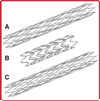Quantification of hemodynamic changes induced by virtual placement of multiple stents across a wide-necked basilar trunk aneurysm
- PMID: 18162911
- PMCID: PMC2756037
- DOI: 10.1227/01.neu.0000306110.55174.30
Quantification of hemodynamic changes induced by virtual placement of multiple stents across a wide-necked basilar trunk aneurysm
Abstract
Objective: The porous intravascular stents that are currently available may not cause complete aneurysm thrombosis and may therefore fail to provide durable protection against aneurysm rupture when used as a sole treatment modality. The goal of this study was to quantify the effects of porous stents on aneurysm hemodynamics using computational fluid dynamics.
Methods: The geometry of a wide-necked saccular basilar trunk aneurysm was reconstructed from a patient's computed tomographic angiography images. Three commercial stents (Neuroform2; Boston Scientific/Target, San Leandro, CA; Wingspan; Boston Scientific, Fremont, CA; and Vision; Guidant Corp., Santa Clara, CA) were modeled. Various combinations of one to three stents were virtually conformed to fit into the vessel lumen and placed across the aneurysm orifice. An unstented aneurysm served as a control. Computational fluid dynamics analysis was performed to calculate the hemodynamic parameters considered important in aneurysm pathogenesis and thrombosis for each of the models.
Results: The complex flow pattern observed in the unstented aneurysm was suppressed by stenting. Stent placement lowered the wall shear stress in the aneurysm, and this effect was increased by additional stent deployment. Turnover time was moderately increased after single- and double-stent placement and markedly increased after three stents were placed. The influence of stent design on hemodynamic parameters was more significant in double-stented models than in other models.
Conclusion: Aneurysm hemodynamic parameters were significantly modified by placement of multiple stents. Because the associated modifications may be helpful as well as harmful in terms of rupture risk, use of this technique requires careful consideration.
Figures








References
-
- Burleson AC, Turitto VT. Identification of quantifiable hemodynamic factors in the assessment of cerebral aneurysm behavior. On behalf of the Subcommittee on Biorheology of the Scientific and Standardization Committee of the ISTH. Thromb Haemost. 1996;76:118–123. - PubMed
-
- Cantón G, Levy DI, Lasheras JC, Nelson PK. Flow changes caused by the sequential placement of stents across the neck of sidewall cerebral aneurysms. J Neurosurg. 2005;103:891–902. - PubMed
-
- Chiu JJ, Chen CN, Lee PL, Yang CT, Chuang HS, Chien S, Usami S. Analysis of the effect of disturbed flow on monocytic adhesion to endothelial cells. J Biomech. 2003;36:1883–1895. - PubMed
Publication types
MeSH terms
Grants and funding
LinkOut - more resources
Full Text Sources
Medical

